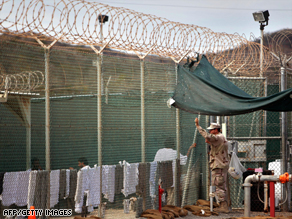Pentagon: Ex-Gitmo detainees turning to terrorism on rise
- Story Highlights
- Pentagon: 14 percent turn to, or are suspected of turning to, terrorism activities
- Rate has doubled from that of a few years ago, Pentagon officials say
- Names of almost 30 ex-detainees believed to have gone on to fight released
CNN Pentagon Producer
WASHINGTON (CNN) -- Mohammed Ismail was released from the U.S. detention facility at Guantanamo Bay, Cuba, in early 2004 and sent back to Afghanistan to be set free.

A guard talks with a detainee at Guantanamo Bay, Cuba, earlier this year.
Within four months, the U.S. military said, he was recaptured in Afghanistan attacking U.S. troops there, with paperwork on him that said he was a Taliban in good standing.
He is just one of 74 former Guantanamo Bay detainees who the military says were active in, or were suspected of being active in, fighting against the United States or committing terrorist acts after being released.
Another is Abdullah Gulam Rasoul, who was released from Guantanamo in December 2007 and set free in Afghanistan. Rasoul has become a powerful Taliban military commander in southern Afghanistan, the military said, and the United States suspects he is responsible for several attacks on U.S. forces there.
A senior U.S. military official said he believes Rasoul is using his former Guantanamo experience to build on his "rock star status" among the Taliban.
Abd al Hadi Abdallah Ibrahim al Shaikh of Saudi Arabia, who was released in 2007, was arrested in 2008 by Saudi authorities on suspicion of supporting terrorism inside that country, the military said.
On Tuesday, the Pentagon released information that showed 14 percent of former detainees have turned to, or are suspected of having turned to, terrorism activity since being released from Guantanamo. The data represent the most recent statistics of former detainees tracked by military and other U.S. government intelligence agencies.
Don't Miss
The report shows that of the more than 530 detainees released from the prison, 27 have been confirmed to have engaged in terrorist activities and 47 are suspected of participating in some kind of terrorist act.
The statistics indicate that there has been a slight increase since the end of 2008, and the number of released detainees turning to or suspected of turning to the insurgency is almost doubled from the 7 percent in that category a few years ago, according to Pentagon officials familiar with the information.
The report said that between December 2008 and March 2009, nine former detainees were added to the confirmed list, six of whom were moved over from the suspected list.
The Pentagon's definition for "suspected" is significant reporting indicating a person is involved in terrorist activities and an analysis showing a match to an identity of a former detainee.
The report defines "confirmed" as a preponderance of evidence, including fingerprints, DNA, photo match or reliable or well-corroborated intelligence that can identify a former detainee at Guantanamo.
In January, Pentagon spokesman Geoff Morrell said 62 former Guantanamo detainees may have gone on to participate in terrorism or military activity. That number included 18 who had been directly tied to an attack or attacks and 43 who were suspected of such action, Pentagon officials said at the time.
"What's clear is we are not seeing recidivism on the decline," according to a defense official who declined to be named because of the sensitivity of the issue.
Pentagon spokesman Bryan Whitman declined to say what officials think is the reason for the numbers having gone up, but said the United States does monitor as best as it can detainees who have been released from Guantanamo.
The Pentagon released the names of almost 30 former detainees confirmed or suspected to have gone on to fight, with examples of what these men had done after their release.
Abdullah Saleh Ali al-Ajmi, for example, was released in 2005 to Kuwait. In April 2008 he blew himself up in Mosul, Iraq, killing a number of Iraqis, the Pentagon said.
Yousef Muhammed Yaaqoub was released from Guantanamo and sent back to Afghanistan to be freed in 2003. The Pentagon documents show that he rejoined the Taliban as a commander in southern Afghanistan, and planned a jailbreak in Kandahar and a "nearly successful capture of the town of Spin Boldak, Afghanistan."
Yaaqoub was killed fighting U.S. troops on May 7, 2004, according to the Pentagon data, and his memorial service in Pakistan drew a number of wanted Taliban leaders.

Other examples released by the Pentagon show men sent home to Morocco who were later captured and accused of recruiting people to train with and fight for al Qaeda in Iraq, two men freed in Saudi Arabia who became leaders in a new al Qaeda organization there, and a Russian sent home who later was arrested for playing a role in a gas line bombing.
As a comparison, among prisoners in the United States, about 62 percent of violent offenders examined in a 1994 study by the Bureau of Justice Statistics were rearrested within three years of being released.
All About Guantanamo Bay • The Pentagon

 Sit tight, we're getting to the good stuff
Sit tight, we're getting to the good stuff